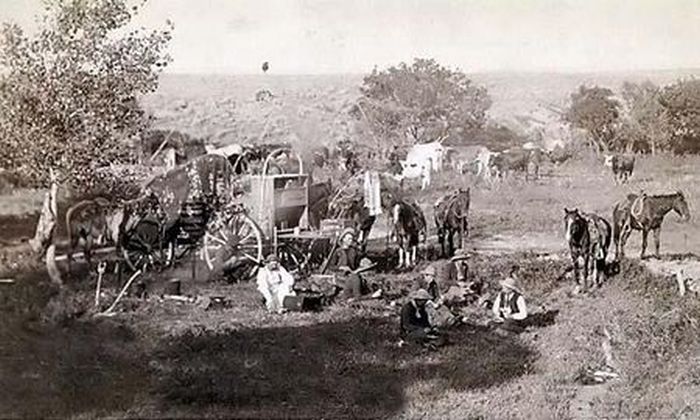|
|
History: American Old West, United States
|
As the frontier moved westward, the establishment of U.S. military forts moved with it, representing and maintaining federal sovereignty over new territories. The military garrisons usually lacked defensible walls but were seldom attacked. They served as bases for troops at or near strategic areas, particularly for counteracting the Indian presence. For example, Fort Bowie protected Apache Pass in southern Arizona along the mail route between Tucson and El Paso and was used to launch attacks against Cochise and Geronimo. Fort Laramie and Fort Kearny helped protect immigrants crossing the Great Plains and a series of posts in California protected miners. Forts were constructed to launch attacks against the Sioux. As Indian reservations sprang up, the military set up forts to protect them. Forts also guarded the Union Pacific and other rail lines. Other important forts were Fort Sill, Oklahoma, Fort Smith, Arkansas, Fort Snelling, Minnesota, Fort Union Montana, Fort Worth, Texas, and Fort Walla Walla in Washington. By the 1890s, with the threat from Indian nations eliminated, and with white populations increasing enough to provide their own law enforcement, most frontier forts were abandoned. Fort Omaha, Nebraska was home to the Department of the Platte, and was responsible for outfitting most Western posts for more than 20 years after its founding in the late 1870s. Fort Huachuca in Arizona was also originally a frontier post which is still in use by the United States Army. During the Mexican Revolution, the United States was forced to build a new series of twelve forts for protection along the Mexican-American border. Fort Naco in Naco, Arizona was one of these. At this time in the southwest United States, towns were still being established and all wilderness was still considered frontier.
• Indian Wars
As settlement sped up across the West after the transcontinental railroad was completed, clashes with Native Americans of the Plains and southwest reached a final phase. The military's mission was to clear the land of free-roaming Indians and put them onto reservations. The stiff resistance after the Civil War of battle-hardened, well-armed Indian warriors resulted in the Indian Wars.
According to Gregory Michno, author of the Encyclopedia of Indian wars: western battles and skirmishes, 1850-1890, there were more conflicts with native Americans in the states bordering Mexico than in the interior states. Arizona ranked highest, with 310 known battles fought within the state's boundaries between Americans and the natives. Also, when determining how many deaths resulted from the wars, in each of the American states, Arizona ranked highest. At least 4,340 people were killed, including soldiers, civilians and native Americans, over twice as many as occurred in Texas, the second highest ranking state. Most of the deaths in Arizona were caused by the Apache. Micho also says that fifty-one percent of the Indian war battles between 1850 and 1890 took place in Arizona, Texas and New Mexico, as well as thirty-seven percent of the casualties in the county west of the Mississippi River.
|
|









